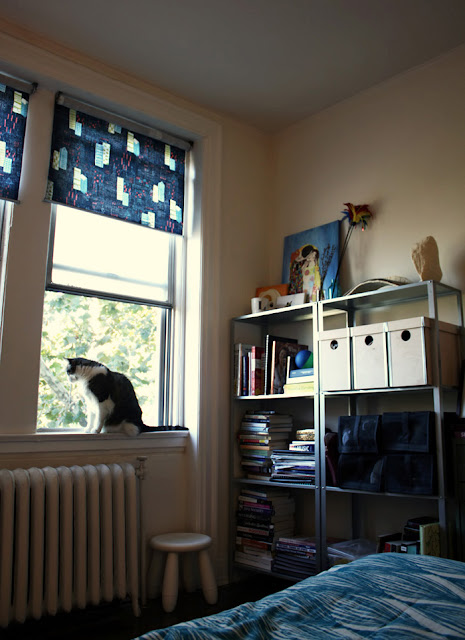Materials: Plastic dropcloth, tape, 2 IKEA ENJEs, 4 yards of fabric, Sobo or another fabric glue, large paintbrush, rubber cement pickup, long metal ruler, two weighted objects (jars work!), sharp scissors, needle & thread (or a sewing machine), power drill, screws
Description: My partner and I moved to our current apartment in May, and before then neither of us had ever lived in a building with radiators. After reading some safety guides, I realized that our curtains would pose a fire hazard. I was looking online for a while for printed roller shades that could block the light from our east-facing windows in the morning, but I couldn't find any that weren't expensive and that would coordinate with the patterns in our room.
I happened upon this tutorial the other day, and decided to try it out. I actually found Lazy Cozy's tutorial to be lacking in some aspects: she does not mention that you absolutely need a dropcloth, otherwise glue will get all over your floor! The fabric will also fray if you don't hem the sides. There was no instruction on what to do with the fabric that meets the end of the shade. My tutorial will expand on hers.
I could not locate her adhesive since she is located in the UK, so I used Sobo, the glue I use for all my modeling projects. It did not leak through my fantastic fabric from Jessica Hogarth, but it did leave blotches on the ENJE fabric. I took pictures of my rollers' current state, but I'm going to buy a dark canvas to cover the backs, because we want total room-darkening.
I found that doing the second shade went a LOT quicker after I figured out what I was doing. The first one probably took me 5 hours. I hand-sewed since I don't own a sewing machine, and I have no idea how to operate one. If you use one, I bet you could finish one shade in under an hour.
1) Iron your fabric. Cut it so that it's a little longer and wider than your shade.
2) Tape down a dropcloth!! Seriously. The ENJE material is sheer, and glue will go right through it.
3) Unroll one shade facing up and tape it to the dropcloth. Make sure the shade is taut, so there are no wrinkles.
4) Lay the fabric on top of the shade, and then weigh down the top and bottom on one side using jars or other heavy objects. Flip the fabric over them.
5) Spread glue with your paintbrush on the shade. Start on the side with the weighted objects. I found that doing it one column at a time and then tacking it down with my metal ruler was very effective at removing wrinkles. This method also ensures that your glue won't dry before you lay the fabric down. After you've completed the one side, remove the weights and glue the rest of the fabric onto the shade.
6) Your fabric should be a little longer than where the ENJE fabric meets the bottom of the shade. Put glue at the base, and then tuck your fabric in with the metal ruler.
7) Use the rubber cement pickup to remove stray glue marks.
8) Wait for the glue to be mostly dry. Flip the shade over, but make sure there is no wet glue on the dropcloth first!
9) Paint glue on the edges of the shade.
10) Wait for the glue to dry, and then cut a straight edge.
11) Hand-sew the edge or use a sewing machine to make sure the fabric doesn't fray.
12) Install the shade following IKEA's instructions with a power drill and screws.
13) Admire your work!
Cost: $80 for both shades, more or less depending on the size you need and the fabric you choose.
Production and installation: 3-8 hours, depending on if you use a sewing machine.
See more of the ENJE roller shades.
~ Luna, Philadelphia, PA








Post A Comment:
0 comments:
Post a Comment